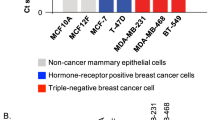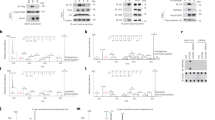Abstract
Histone acetyltransferases (HATs) have a central role in the modification of chromatin as well as in the pathogenesis of a broad set of diseases including cancers. Gcn5 is the first identified transcription-related HAT that has been implicated in the regulation of diverse cellular functions. However, how Gcn5 proteins are regulated remains largely unknown. Here we show that acidic nucleoplasmic DNA-binding protein (And-1, a high mobility group domain-containing protein) has remarkable capability to regulate the stability of Gcn5 proteins and thereby histone H3 acetylation. We find that And-1 forms a complex with both histone H3 and Gcn5. Downregulation of And-1 results in Gcn5 degradation, leading to the reduction of H3K9 and H3K56 acetylation. And-1 overexpression stabilizes Gcn5 through protein-protein interactions in vivo. Furthermore, And-1 expression is increased in cancer cells in a manner correlating with increased Gcn5 and H3K9Ac and H3K56Ac. Thus, our data reveal not only a functional link between Gcn5 and And-1 that is essential for Gcn5 protein stability and histone H3 acetylation, but also a potential role of And-1 in cancer.
This is a preview of subscription content, access via your institution
Access options
Subscribe to this journal
Receive 50 print issues and online access
$259.00 per year
only $5.18 per issue
Buy this article
- Purchase on Springer Link
- Instant access to full article PDF
Prices may be subject to local taxes which are calculated during checkout







Similar content being viewed by others
References
Armas-Pineda C, Arenas-Huertero F, Perezpenia-Diazconti M, Chico-Ponce de Leon F, Sosa-Sainz G, Lezama P et al. (2007). Expression of PCAF, p300 and Gcn5 and more highly acetylated histone H4 in pediatric tumors. J Exp Clin Cancer Res 26: 269–276.
Atanassov BS, Evrard YA, Multani AS, Zhang Z, Tora L, Devys D et al. (2009). Gcn5 and SAGA regulate shelterin protein turnover and telomere maintenance. Mol Cell 35: 352–364.
Bermudez VP, Farina A, Tappin I, Hurwitz J . (2009). Influence of the human cohesion establishment factor Ctf4/AND-1 on DNA replication. J Biol Chem 285: 9493–9505.
Brand M, Moggs JG, Oulad-Abdelghani M, Lejeune F, Dilworth FJ, Stevenin J et al. (2001). UV-damaged DNA-binding protein in the TFTC complex links DNA damage recognition to nucleosome acetylation. EMBO J 20: 3187–3196.
Brownell JE, Zhou J, Ranalli T, Kobayashi R, Edmondson DG, Roth SY et al. (1996). Tetrahymena histone acetyltransferase A: a homolog to yeast Gcn5p linking histone acetylation to gene activation. Cell 84: 843–851.
Burgess RJ, Zhang Z . (2010). Roles for Gcn5 in promoting nucleosome assembly and maintaining genome integrity. Cell Cycle 9: 2979.
Burgess RJ, Zhou H, Han J, Zhang Z . (2010). A role for Gcn5 in replication-coupled nucleosome assembly. Mol Cell 37: 469–480.
Bustin M . (1999). Regulation of DNA-dependent activities by the functional motifs of the high-mobility-group chromosomal proteins. Mol Cell Biol 19: 5237–5246.
Cavusoglu N, Brand M, Tora L, Van Dorsselaer A . (2003). Novel subunits of the TATA binding protein free TAFII-containing transcription complex identified by matrix-assisted laser desorption/ionization-time of flight mass spectrometry following one-dimensional gel electrophoresis. Proteomics 3: 217–223.
Celic I, Verreault A, Boeke JD . (2008). Histone H3 K56 hyperacetylation perturbs replisomes and causes DNA damage. Genetics 179: 1769–1784.
Collins SR, Miller KM, Maas NL, Roguev A, Fillingham J, Chu CS et al. (2007). Functional dissection of protein complexes involved in yeast chromosome biology using a genetic interaction map. Nature 446: 806–810.
Das C, Lucia MS, Hansen KC, Tyler JK . (2009). CBP/p300-mediated acetylation of histone H3 on lysine 56. Nature 459: 113–117.
Espinosa MC, Rehman MA, Chisamore-Robert P, Jeffery D, Yankulov K . (2010). GCN5 is a positive regulator of origins of DNA replication in Saccharomyces cerevisiae. PLoS ONE 5: e8964.
Gambus A, van Deursen F, Polychronopoulos D, Foltman M, Jones RC, Edmondson RD et al. (2009). A key role for Ctf4 in coupling the MCM2-7 helicase to DNA polymerase alpha within the eukaryotic replisome. EMBO J 28: 2992–3004.
Goren A, Tabib A, Hecht M, Cedar H . (2008). DNA replication timing of the human beta-globin domain is controlled by histone modification at the origin. Genes Dev 22: 1319–1324.
Grant PA, Eberharter A, John S, Cook RG, Turner BM, Workman JL . (1999). Expanded lysine acetylation specificity of Gcn5 in native complexes. J Biol Chem 274: 5895–5900.
Grosschedl R, Giese K, Pagel J . (1994). HMG domain proteins: architectural elements in the assembly of nucleoprotein structures. Trends Genet 10: 94–100.
Hanna JS, Kroll ES, Lundblad V, Spencer FA . (2001). Saccharomyces cerevisiae CTF18 and CTF4 are required for sister chromatid cohesion. Mol Cell Biol 21: 3144–3158.
Im JS, Ki SH, Farina A, Jung DS, Hurwitz J, Lee JK . (2009). Assembly of the Cdc45-Mcm2-7-GINS complex in human cells requires the Ctf4/And-1, RecQL4, and Mcm10 proteins. Pro Natl Acad Sci USA 106: 15628–15632.
Karnani N, Taylor C, Malhotra A, Dutta A . (2007). Pan-S replication patterns and chromosomal domains defined by genome-tiling arrays of ENCODE genomic areas. Genome Res 17: 865–876.
Kikuchi H, Kuribayashi F, Takami Y, Imajoh-Ohmi S, Nakayama T . (2011). GCN5 regulates the activation of PI3K/Akt survival pathway in B cells exposed to oxidative stress via controlling gene expressions of Syk and Btk. Biochem Biophys Res Commun 405: 657–661.
Kouprina N, Kroll E, Bannikov V, Bliskovsky V, Gizatullin R, Kirillov A et al. (1992). CTF4 (CHL15) mutants exhibit defective DNA metabolism in the yeast Saccharomyces cerevisiae. Mol Cell Biol 12: 5736–5747.
Kuo MH, Brownell JE, Sobel RE, Ranalli TA, Cook RG, Edmondson DG et al. (1996). Transcription-linked acetylation by Gcn5p of histones H3 and H4 at specific lysines. Nature 383: 269–272.
Lang SE, McMahon SB, Cole MD, Hearing P . (2001). E2F transcriptional activation requires TRRAP and GCN5 cofactors. J Biol Chem 276: 32627–32634.
Lee KK, Workman JL . (2007). Histone acetyltransferase complexes: one size doesn’t fit all. Nat Rev Mol Cell Biol 8: 284–295.
Liu X, Tesfai J, Evrard YA, Dent SY, Martinez E . (2003). c-Myc transformation domain recruits the human STAGA complex and requires TRRAP and GCN5 acetylase activity for transcription activation. J Biol Chem 278: 20405–20412.
Lucas I, Palakodeti A, Jiang Y, Young DJ, Jiang N, Fernald AA et al. (2007). High-throughput mapping of origins of replication in human cells. EMBO Rep 8: 770–777.
Masumoto H, Hawke D, Kobayashi R, Verreault A . (2005). A role for cell-cycle-regulated histone H3 lysine 56 acetylation in the DNA damage response. Nature 436: 294–298.
Mayer ML, Pot I, Chang M, Xu H, Aneliunas V, Kwok T et al. (2004). Identification of protein complexes required for efficient sister chromatid cohesion. Mol Biol Cell 15: 1736–1745.
Nagy Z, Tora L . (2007). Distinct GCN5/PCAF-containing complexes function as co-activators and are involved in transcription factor and global histone acetylation. Oncogene 26: 5341–5357.
Orpinell M, Fournier M, Riss A, Nagy Z, Krebs A, Frontini M et al. (2010). The ATAC acetyl transferase complex controls mitotic progression by targeting non-histone substrates. EMBO J 29: 2381–2394.
Paolinelli R, Mendoza-Maldonado R, Cereseto A, Giacca M . (2009). Acetylation by GCN5 regulates CDC6 phosphorylation in the S phase of the cell cycle. Nat Struct Mol Biol 16: 412–420.
Petronczki M, Chwalla B, Siomos MF, Yokobayashi S, Helmhart W, Deutschbauer AM et al. (2004). Sister-chromatid cohesion mediated by the alternative RF-CCtf18/Dcc1/Ctf8, the helicase Chl1 and the polymerase-alpha-associated protein Ctf4 is essential for chromatid disjunction during meiosis II. J Cell Sci 117: 3547–3559.
Shahbazian MD, Grunstein M . (2007). Functions of site-specific histone acetylation and deacetylation. Annu Rev Biochem 76: 75–100.
Shechter D, Dormann HL, Allis CD, Hake SB . (2007). Extraction, purification and analysis of histones. Nat Protoc 2: 1445–1457.
Tamburini BA, Tyler JK . (2005). Localized histone acetylation and deacetylation triggered by the homologous recombination pathway of double-strand DNA repair. Mol Cell Biol 25: 4903–4913.
Tjeertes JV, Miller KM, Jackson SP . (2009). Screen for DNA-damage-responsive histone modifications identifies H3K9Ac and H3K56Ac in human cells. EMBO J 28: 1878–1889.
Tsutsui Y, Morishita T, Natsume T, Yamashita K, Iwasaki H, Yamao F et al. (2005). Genetic and physical interactions between Schizosaccharomyces pombe Mcl1 and Rad2, Dna2 and DNA polymerase alpha: evidence for a multifunctional role of Mcl1 in DNA replication and repair. Curr Genet 48: 34–43.
Vogelauer M, Rubbi L, Lucas I, Brewer BJ, Grunstein M . (2002). Histone acetylation regulates the time of replication origin firing. Mol Cell 10: 1223–1233.
Wang L, Mizzen C, Ying C, Candau R, Barlev N, Brownell J et al. (1997). Histone acetyltransferase activity is conserved between yeast and human GCN5 and is required for complementation of growth and transcriptional activation. Mol Cell Biol 17: 519–527.
Wang YL, Faiola F, Xu M, Pan S, Martinez E . (2008). Human ATAC Is a GCN5/PCAF-containing acetylase complex with a novel NC2-like histone fold module that interacts with the TATA-binding protein. J Biol Chem 283: 33808–33815.
Williams DR, McIntosh JR . (2002). mcl1+, the Schizosaccharomyces pombe homologue of CTF4, is important for chromosome replication, cohesion, and segregation. Eukaryot Cell 1: 758–773.
Yoshizawa-Sugata N, Masai H . (2009). Roles of human AND-1 in chromosome transactions in S phase. J Biol Chem 284: 20718–20728.
Zhou J, Chau C, Deng Z, Stedman W, Lieberman PM . (2005). Epigenetic control of replication origins. Cell Cycle 4: 889–892.
Zhu W, Chen Y, Dutta A . (2004). Rereplication by depletion of geminin is seen regardless of p53 status and activates a G2/M checkpoint. Mol Cell Biol 24: 7140–7150.
Zhu W, Ukomadu C, Jha S, Senga T, Dhar SK, Wohlschlegel JA et al. (2007). Mcm10 and And-1/CTF4 recruit DNA polymerase alpha to chromatin for initiation of DNA replication. Genes Dev 21: 2288–2299.
Acknowledgements
We thank Anindya Dutta for And-1 plasmids and antibodies, Ezra Burstein for Gcn5 plasmids, Rakesh Kumar and Jeyanthy Eswaran for reading the manuscript. This work was supported by funding from the National Institutes of Health (4R00CA136555 awarded to WZ; CA120316 awarded to NHL).
Author information
Authors and Affiliations
Corresponding author
Ethics declarations
Competing interests
The authors declare no conflict of interest.
Rights and permissions
About this article
Cite this article
Li, Y., Jaramillo-Lambert, A., Yang, Y. et al. And-1 is required for the stability of histone acetyltransferase Gcn5. Oncogene 31, 643–652 (2012). https://doi.org/10.1038/onc.2011.261
Received:
Revised:
Accepted:
Published:
Issue Date:
DOI: https://doi.org/10.1038/onc.2011.261
Keywords
This article is cited by
-
Integrative bioinformatics analysis of WDHD1: a potential biomarker for pan-cancer prognosis, diagnosis, and immunotherapy
World Journal of Surgical Oncology (2023)
-
STAT3 plays an important role in DNA replication by turning on WDHD1
Cell & Bioscience (2021)
-
WDHD1 facilitates G1 checkpoint abrogation in HPV E7 expressing cells by modulating GCN5
BMC Cancer (2020)
-
Histone Deacetylase Inhibitors Globally Enhance H3/H4 Tail Acetylation Without Affecting H3 Lysine 56 Acetylation
Scientific Reports (2012)



